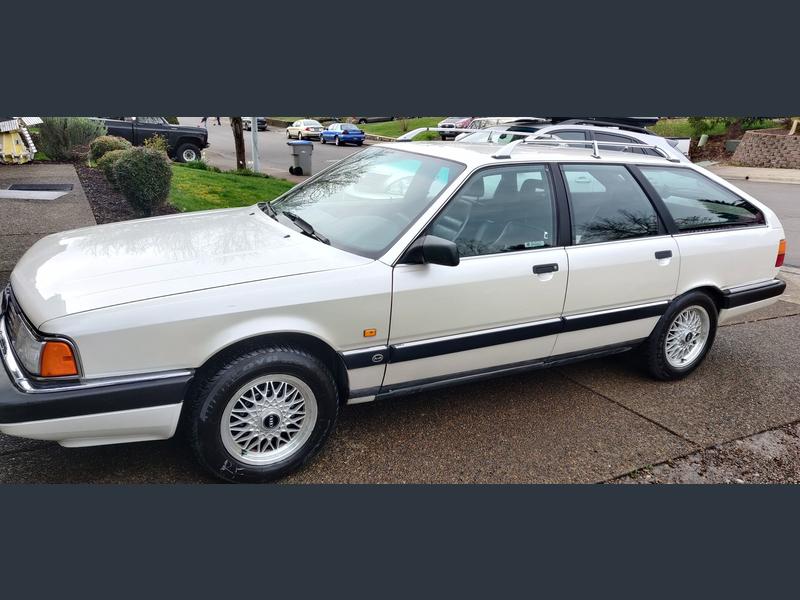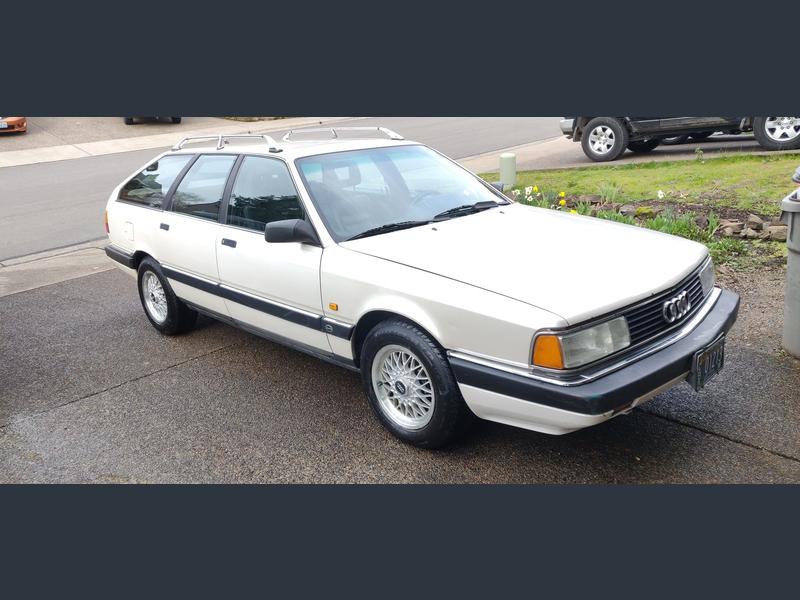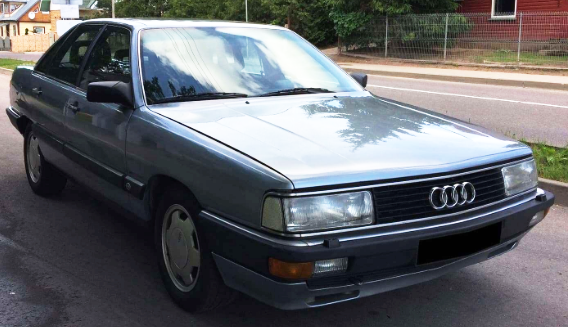A look back at the top 10 posts on our blog from the past year. What German enthusiast autos are you looking for in 2023?…
2 CommentsTag: 200
This site contains Ebay partner affiliate links, which may earn us a commission at no additional cost to you.
1991 Audi 200 quattro Avant
1991 was a great year for Audi and Volkswagen enthusiasts in America, robust with performance options all around. Fans of normally aspirated motors had multiple double-cam choices; the 16V twins from Volkswagen with the GTI/GLIs, each with heavily bolstered Recaros and awesome BBS wheels. Going slightly less boy racer and more upscale yielded the equally impressive 20V inline-5 duo from Audi, with the Coupe Quattro and 90 20V quattro. They weren’t as quick off the line, but they were certainly well built, solid performing luxury vehicles. Of course, the big daddy of normal aspiration in the lineup was the V8 quattro. Still at 3.6 liters and 240 horsepower for 1991, it was also available with a manual transmission and was in the midst of a winning streak in the DTM series, usurping power from the E30 M3 and 190E 2.5-16 in monumental style.
If forced induction was more your choice for speed, there were plenty of options there, as well. 1991 featured a slightly revised Corrado, now also with BBS wheels and the 1.8 liter G-lader supercharged motor. Audi offered you a luxury cruiser still in the 200 Turbo, as well. But the big news was finally the release of the 20V Turbo motor into the lineup. Long featured in the Sport Quattro, then RR Quattro in Europe and later S2, in America Audi brought the 3B turbocharged inline-5 package in the 200. As an added bonus, it was available in both sedan form and the innovative Avant wagon. Producing 217 horsepower and a bit more torque, the Audi was capable of 0-60 runs in the mid-6 second range if you were quick with your shifts. But this wasn’t a bracket racer – the 200 was a luxury car through and through, with a well-appointed cabin full of the things you’d expect – Zebrano wood trim, electric powered and heated leather seats front and rear, and a high-quality Bose stereo. Unusual for a luxury car of the time, but underscoring the German’s feelings towards driving, were the number of driver-oriented items. The dash was full of gauges, and unlike the V8 and 200 Turbo, the 20V was manual-only. Next to the shift lever was the manual rear differential lock, though as with all the second generation quattro drivetrains, the electronic lock disengaged at 15 m.p.h. automatically. The center differential was a Torsen unit capable of varying power as well. And the brakes were unconventional floating-rotor designs, intended to help haul the heavy 200 down from triple-digit Autobahn speed with ease. Unlike the normal 200, the fenders on the 20V were flared slightly to accommodate BBS forged wheels, 15×7.5″ all around and shared with the V8 quattro. It sounded like a recipe for success, and was a well regarded car when new even if the unconventional manual/turbo-5 setup lacked some grunt compared to the V8s of the day.
Yet this was still the fallout period of both the recession of the 1990s and Audi’s fall from grace in the U.S. market, so the 200 was a slow seller. On top of that, the C3 was at the very end of its life cycle, replaced mid-1991 with the C4 chassis. As a result, very few of the 200 20V quattros were built; Audi claims 4,767 sedans and a scant 1,616 Avants were produced with the 3B motor. Of those, only about 900 sedans made it to America. But the number you care about? Well, this 1991 200 20V quattro Avant is one of the 149 originally imported here.
CLICK FOR DETAILS: 1991 Audi 200 quattro Avant on Autotrader
3 Comments1990 Audi 200 quattro Avant
Although the C3 Audi chassis enjoyed a reasonably long production run of 1984-1991, each year introduced changes that, while evolutionary, were notable and make each specific model year feel a little bit bespoke. The biggest change was the 1986 introduction of Audi’s all-wheel drive system of quattro to the large model range, making three distinct packages you could get the unique drivetrain in the luxury market. In the U.S. market, 1986 5000 quattros came only in “CS” spec and sedan – basically, fully loaded with only heated seats, Fuchs forged wheels and Pearlescent White Metallic paint as options. 1987 opened the options, but not with more gadgetry – the Avant, previously only available in front drive normally aspirated “S” form, joined the quattro lineup full time after being introduced about halfway through the 1986 model run. Alcantara also became a seldom-selected option. 1988 saw a very minor revision to the turbocharged “CS” models with new script badges in the rear and a few more options including heating for the rear seats and Velour interior options, but the big news was a new “5000S quattro” model, which came sans turbo and without the twin-bulb headlights, but shared the big brother turbo brakes and wheels. It was a smart move to drop the price on the quattro models, as the normal run 5000 reported outsold the 5000CS quattro by a measure of 4:1!
1989 was highlighted by a complete model refresh, moving to the European “100/200? model designations. Accompanying the change were some new colors and minor alterations, such as more upscale-looking 15?x6” BBS wheels (color matched on Pearlescent White Metallic examples, just as the aero and Fuchs wheels had been). But inside an entirely new sweeping dashboard setup would be the standard on big Audis for the next 7 years. Instead of the previously confusing “S/CS” monikers, turbocharged models now wore the 200 badge, while normally aspirated models were 100s. The Alcantara and Velour options disappeared on the 200 models, which came only fully-loaded, and Fuchs were no longer an option. The 100 quattro shared many components with the 80/90 quattros from the same time, including the NG normally aspirated motor instead of the turbocharged MC1. 100s also ran the familiar small-chassis 4×108 bolt pattern with accompanying smaller brakes, but oldly Audi commissioned BBS to make a run of 15?x6? wheels that matched the look of the 200’s wheels outwardly. Mechanically, otherwise there were few changes to either model, though as with the 80/90 quattros, the option to lock your own differential was now limited to the rear, and then speed limited to 15 m.p.h.. While 1990 saw few changes to the run overall, there was a change in motor in the 200. A rolling change saw the revised (and very short lived) MC2 replace the MC1. Twin knock sensors allowed engineers to run higher compression; coupled with a reground camshaft, lighter mass flywheel and smaller K24 turbo meant that the MC2 could run less boost and spool more quickly for a better driving experience, but ultimately the facts and figures say the power was unchanged. As always, top of the heap was the 200 quattro Avant, like this Zermatt Silver Metallic example:
CLICK FOR DETAILS: 1990 Audi 200 quattro Avant on eBay
1 Comment1989 Audi 200 quattro
It’s hard for me to believe that it’s been well over a decade since I bid farewell to my Audi 200. It was never meant to be; I had always admired the turbocharged Avants and so when one came up for sale for an incredibly low asking price, I jumped.
Turned out it was more than just me that needed a jump. And it turned out that the 200 needed a lot more than just a jump; the clutch was thoroughly fried, as were the brakes, and the fuel system, and a few other odds and ends. I patched it together and we enjoyed a memorable run of events. Of all my automotive calamity stories, about 50% revolve around both of my big body Audis. The V8 created more hair-raising events (such as the time the throttle stuck wide open and in an effort to stop it I managed to set the brakes on fire), but the 200 wasn’t to be outdone.
There was the time I left the tollbooth on the Mass Pike. The car was running particularly well that day, so I gave it WOT leaving the gate. First to second and the nose was pointed at the sky! Surely, everyone must be saying “WOOOOOOOW!!!“, and it turns out they were because I had blown an oil cooler line and was crop dusting Sturbridge with a thick coat of atomized 10W-40. Another time the voltage regulator died, leaving me to switch various electrical items on and off to balance the charge between 11.5 and 14 volts all the ride home from Cape Cod. It blew several tires while on the road, which admittedly probably wasn’t it’s fault but was exciting nonetheless. I found out that the ABS worked – well – in an ice storm on 95 one time as I passed a braking BMW on the hard shoulder. The coolant lines froze one day – a major feat, since there was theoretically coolant in them. It twice threw alternator belts, leaving me to drive home the length of Rt. 24 at 5am with no lights on. The air conditioner didn’t work. Actually, basically everything electronic didn’t work particularly well if I’m honest. The radio’s blown speakers weren’t enough to overcome the wind noise created by the necessity to have the windows down at all times if the outside temp was over 60. But the kicker? The kicker was that the brake lines collapsed, leaving the calipers to randomly seize partially closed. As a result, you had to go full throttle to maintain 50 mph which, as you read at the beginning of this passage, occasionally presented an explosive problem. I gave up eventually, unable to stomach this car consuming more of my money.
Sound charming? It was. But most of my issues probably would have been remedied if I simply had bought a better example:
CLICK FOR DETAILS: 1989 Audi 200 quattro on eBay
7 CommentsRight Hooker Week: 1983 Audi 200 Turbo
After yesterday’s South African 500SE, this 200 Turbo is an interesting counterpoint for several reasons. First, if the age is correct, it’s from the very beginning of Type 44 production. In fact, it wasn’t until September 1983 that the turbocharged variant of the new Type 44 – the 200 – was available for the marketplace. So this car represents the beginning of the run compared to yesterday’s run-ending 500SE.
What’s amazing to me is how little change there was in that period. Outside of the interior refresh, a slightly different exterior color and some small details, the 1983 and 1990 model years could pass for contemporaries. Try that in other model ranges today! Of course, one other reason this car is interesting is the turbo. This would be an early 2.1 liter unit, rated nominally at 182 horsepower – a healthy bit more power than the late NF motor (130 horsepower). What’s unusual in this case is that it’s mated to a 5-speed manual transmission. Of course, these were the days before the quattro drive setup moved into other models outside of the halo Quattro, so you’re stuck with a front-driver only.
Oh, and one more oddity? Well, it’s being sold in the U.K., but it’s left hand drive.







